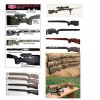No Fear in Accuracy
Well-Known Member
I wondered myself why do shooters/hunters prefer this type of stock instead of similar stock.
Mind you, I have a McMillan A-5 Adj. cheekpiece stock, using 6BR cartridge.
I've researched and gather all information I need to build for my next project. My long range project will be either 338 AM/338 Snipetac or 338 Raptor.
It seems that most popular are McMillan A-5 or Manners. That will handle high powered cartridge due to twist, shifting and better design.
When I shoot at long range, I only touch with my thumb on the grip, one finger on the trigger, cheek weld lightly on the cheekpiece and shoulder lightly touches the butt.
So why did you choose this stock over other stock? Based on looks, feel and weight?
I wonder if I can use the laminated wood stock for high powered rifle. (see the picture below, red stripes on black). The price is around $200.
McMillan A-5 is approaching $700 to $900.
Mind you, I have a McMillan A-5 Adj. cheekpiece stock, using 6BR cartridge.
I've researched and gather all information I need to build for my next project. My long range project will be either 338 AM/338 Snipetac or 338 Raptor.
It seems that most popular are McMillan A-5 or Manners. That will handle high powered cartridge due to twist, shifting and better design.
When I shoot at long range, I only touch with my thumb on the grip, one finger on the trigger, cheek weld lightly on the cheekpiece and shoulder lightly touches the butt.
So why did you choose this stock over other stock? Based on looks, feel and weight?
I wonder if I can use the laminated wood stock for high powered rifle. (see the picture below, red stripes on black). The price is around $200.
McMillan A-5 is approaching $700 to $900.

